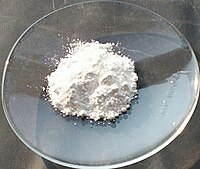
Photo from wikipedia
AIMS The rise in antibiotic resistance requires the reduction of antibiotic use in all sectors. In animal production, many commercial alternatives to antibiotics have been developed for incorporation into feeds,… Click to show full abstract
AIMS The rise in antibiotic resistance requires the reduction of antibiotic use in all sectors. In animal production, many commercial alternatives to antibiotics have been developed for incorporation into feeds, but a lack of evidence on their antibacterial activity limits confidence in their application. We aim to compare the antibacterial activity of feed additives and active ingredients to better understand their usefulness. METHODS AND RESULTS The antibacterial activity of thirty-four active ingredients and feed additives, including medium and short chain organic acids and essential oils, were tested against pure cultures of five bacterial swine pathogens. Antibacterial activity was observed using an agar-plug diffusion method and quantified via broth-microdilution. A diverse range of antibacterial activities were observed. The highest inhibitory activity against S. aureus and S. suis was exhibited by the C12 monoglyceride (0.49 mg ml-1 ). The monoglyceride of C12 was more effective than C12:0 against S. suis, but neither C12:0 nor its monoglyceride showed efficacy against the gram-negative microorganisms tested. The most active against E. coli were the C6:0 MCOA and potassium diformate (1.95 mg ml-1 ). For S. Typhimurium; potassium diformate, sodium diformate, and a blend of C8:0/C10:0 (each 1.96 mg ml-1 ), and for A. pleuropneumoniae; eugenol (0.49 mg ml-1 ), showed the most promising activity. CONCLUSIONS We identified broad-spectrum antibacterial activity, such as the C6:0 MFOA, and those with interesting narrow-spectrum activity, notably the killing of S. suis by C12 monoglyceride. We have identified additives which show the most promising bioactivity against specific pathogens. SIGNIFICANCE AND IMPACT OF THE STUDY We broadly compare a large collection of feed additives and active ingredients for their antibacterial activity against a diverse panel of bacterial swine pathogens. This provides a solid base of evidence which can drive the development of feed supplementation strategies with the aim of reducing dependency on antibiotic use in swine production.
Journal Title: Journal of applied microbiology
Year Published: 2021
Link to full text (if available)
Share on Social Media: Sign Up to like & get
recommendations!